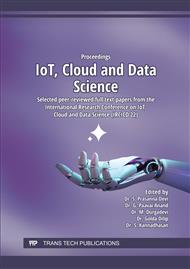[1]
Rachmawan Adi Laksono, Kelly Rossa Sungkono and Riyanarto Sarno Sentiment Analysis of Restaurant Customer Reviews on TripAdvisor using Naive Bayes,, J12th International Conference on Information & Communication Technology and System (lCTS) (2019).
DOI: 10.1109/icts.2019.8850982
Google Scholar
[2]
Kanwal Zahoor, Narmeen Zakaria Bawany and Soomaiya HamidK. Elissa, Sentiment Analysis and Classification of Restaurant Reviews using Machine Learning,, 21st International Arab Conference on Information Technology (ACIT) ,(2020).
DOI: 10.1109/acit50332.2020.9300098
Google Scholar
[3]
Jinat Ara1, Md. Toufique Hasan, Abdullah Al Omar, Hanif Bhuiyan., Understanding Customer Sentiment: Lexical Analysis of Restaurant Reviews,, IEEE Region 10 Symposium (TENSYMP), 5-7 June 2020, Dhaka, Bangladesh,(2020).
DOI: 10.1109/tensymp50017.2020.9230712
Google Scholar
[4]
M. Nakayama. and Y. Wan, The cultural impact on social commerce: A sentiment analysis on Yelp ethnic restaurant reviews. Information Management, 2019. 56(2): p.271-279M.
DOI: 10.1016/j.im.2018.09.004
Google Scholar
[5]
G. Somprasertsri. and P. Lalitrojwong, Mining Feature-Opinion in Online Customer Reviews for Opinion Summarization. J. UCS, 2010. 16(6): pp.938-955.
Google Scholar
[6]
D. Grabner, M. Zanker, G. Fliedl, M. Fuchs, and others, Classification of customer reviews based on sentiment analysis. Citcsccr, 2012.
Google Scholar
[7]
D. Grabner, M. Zanker, G. Fliedl, M. Fuchs, and others, Classification of customer reviews based on sentiment analysis. Citcsccr, 2012.
Google Scholar
[8]
U. W. Wijayanto and R. Sarno, An Experimental Study of Supervised Sentiment Analysis Using Gaussian Naive Bayes,, in 2018 International Seminar on Application for Technology of Information and Communication, 2018, p.476--481.
DOI: 10.1109/isemantic.2018.8549788
Google Scholar
[9]
Nivet Chirawichitchai, Sentiment Classification by a Hybrid Method of Greedy Search and Multinomial Naïve Bayes Algorithm,, 2013 Eleventh International Conference on ICT and Knowledge Engineering.
DOI: 10.1109/ictke.2013.6756285
Google Scholar
[10]
Ayodeji Olalekan Salau, Shruti Jain, A Review on Feature Selection and Feature Extraction for Text Classification,, IEEE WiSPNET 2016 conference.
Google Scholar
[11]
Pang, B., Lee, L., and Vaithyanathan, S. Thumbs up? Sentiment Classification using Machine Learning Techniques. In Proceedings of Conference on Empirical Methods in Natural Language Processing, 2002. pp.79-86.
DOI: 10.3115/1118693.1118704
Google Scholar
[12]
Pang, B., and Lee, L. A Sentimental Education: Sentiment Analysis Using Subjectivity Summarization Based on Minimum Cuts. In Proceedings of the 42nd Annual Meeting on Association for Computational Linguistics, 2004. pp.271-278.
DOI: 10.3115/1218955.1218990
Google Scholar
[13]
Pang, B., and Lee, L. Opinion mining and sentiment analysis. Foundations and Trends in Information Retrieval, Vol 2(1), 2008. p.1– 135.
Google Scholar


